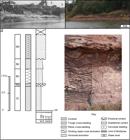Abstract
Abstract: This study defines the neostratotype of the Lower-Middle Albian Itapecuru Formation in the Parnaíba Basin, Northeast Brazil. In this sedimentary succession along the right bank of the Itapecuru River near the Itapecuru-Mirim City, Maranhão State, three lithofacies associations are recognized. The first is silty claystone with some very fine sand, micaceous, reddish color, thin laminated, showing a tabular aspect, interpreted as floodplain fines in a distal position. The second is clayey siltstone, reddish color, with ripple cross-lamination, very thin cross-laminated wacke lenses, grading to thin parallel lamination, in apparently tabular layers, interpreted as crevasse splay and distributive channels deposits in successive avulsion events. The third is fine quartz wacke, reddish to grayish color, showing grouped trough cross bedding, interpreted as channel filling deposits. These facies associations correspond to part of a fluvial depositional system, with predominantly fine-grained rocks, and small lakes in the floodplain, in an oxidizing environment and marked by seasonality. These field data, reinforced by grain size and petrographic analyses showed that, contrary to previous descriptions, the Itapecuru Formation consists mainly of mudrocks. This research also shows that the medium to coarse sandstones and conglomerates, previously included in the Itapecuru Formation, belong to the underlying Grajaú Formation.
Key words
Itapecuru Formation; lithofacies; mudrocks; neostratotype; Mesozoic Stratigraphy; Parnaíba Basin

 Thumbnail
Thumbnail
 Thumbnail
Thumbnail
 Thumbnail
Thumbnail
 Thumbnail
Thumbnail
 Thumbnail
Thumbnail
 Thumbnail
Thumbnail





